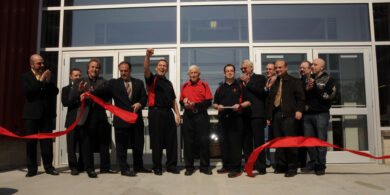Feb. 9, 2009 – Into the great E-mail abyss
By Neil Pascale
Editor
Bud Matto, a Pennsylvania dealer principal, had a hot one.
“He’s definitely price-conscious,” Matto said of a prospective new motorcycle consumer who had started his shopping online. The bike shopper had received a number of e-mail estimates, up to $300 lower than what Matto quoted, but that didn’t dissuade the dealer. “I e-mailed him and asked, ‘Can we talk voice-to-voice?’” Matto said. “He just e-mailed me back, ‘Yes, I’ll call you back on my lunch break.’”
The owner of Matto Cycle, a multibrand dealership in Pottsville, Pa., has all online leads sent straight to his
e-mail, realizing the growing importance of these often first encounters with consumers. New bike buyers’ online shopping habits have increased even more than just a year ago, according to the 2008 J.D. Power and Associates’ Motorcycle Competitive Information Study.
Similar heightened online shopping activity is being found by dealership Web site providers. 50 Below, in a study conducted for Powersports Business, found requests for online quotes and brochures up last year compared to 2007. The study, which looked at 20 random dealerships in 16 states, discovered requests for price quotes up nearly 77 percent over 2007 and brochure requests had more than doubled.
Those increases certainly echo what the rest of the retail world is reporting.
Don Becklin, president of Motorcycle Superstore, one of the largest online PG&A sellers, says retail studies show that 60-75 percent of consumers do research online before making a purchase or visiting a local store.
A September survey of retail consumers shopping for another type of big-ticket item, home electronics, found just under 80 percent of consumers believe the Internet to be “important” in helping them make a decision on which item to purchase.
Yet, there is evidence that shows not all powersports dealerships are fully taking advantage of this type of consumer shopping.
According to a 2008 survey, motorcycle dealers respond to a consumer’s e-mail inquiry within 24 hours only 30 percent of the time, according to a national benchmarking study that examines the effectiveness of the motorcycle industry’s sales force. The survey of more than 800 dealerships, called the Prospect Satisfaction Index by Pied Piper Management Co., shows the motorcycle industry well behind the auto industry in this effort. The auto industry was twice as likely in 2008 to return a customer e-mail inquiry within 24 hours in comparison to motorcycle dealers.
Matto of the Pennsylvania dealership has seen this first-hand, noting one customer told him he sent out 10 e-mail inquiries. “When he was purchasing the motorcycle two weeks later, he said I was the only dealer that got back to him,” Matto said, noting, “and I got back to him 10 minutes after he sent it.”
Tracking the success of moving an online new unit consumer to an in-house buyer seems to be rare among dealerships. The Engelhart Center, a multibrand dealership in Madison, Wis., is one exception as General Manager Robert Hintz reports a 20 percent closing ratio. That number, however, is a work in progress as Hintz notes his staff does not count some leads that are extremely unlikely buyers.
Still, the store does have an online lead process it follows. If the e-mail shopper is asking general questions, the store’s Internet manager might consult with sales staff before responding to the consumer. If the query asks for a specific price quote or a trade-in value, then that is considered a “hot lead” and is given to the general manager, Hintz. He’ll then figure out the value or the price quote and provide that to the Internet manager, who will respond to the e-mail query.
“We just look at it as the person took the time to e-mail us so they must be interested,” Hintz said of the importance of online leads.
Family Powersports, a company that operates five dealerships in Texas, recently changed how it handles online shopping. The dealership group in November assigned one person to oversee all five stores’ online leads and inventory displays, says Colby Richardson, the dealership group’s marketing director. Previously, each store assigned one salesperson to manage the online inventory.
“It was so much extra work for sales professionals to keep up with online inventory that it was taking them off the sales floor and they weren’t having the opportunity to sell the walk-in traffic,” Richardson said.
On the other hand, the inability to get inventory posted online in a timely manner also had a negative impact. “We weren’t getting leads coming back in that we probably should have,” Richardson said.
While many dealership personnel view the online shopper as particularly price-conscious, data seems to point to the fact that they are much more than just lookeloos. Online data provided by PowerSports Network, a leading Web site provider to dealers, shows new unit leads increase in number substantially from April through July, the prime on-road motorcycle selling season. The same is seen with leads relating to the preowned market.
“Yeah you definitely have price-shoppers,” Matto said, summarizing the type of online consumers he experiences. “But I don’t necessarily think people are always shopping for price. Sometimes they’re shopping for a good, quality dealer.” psb?
Bud Matto, a Pennsylvania dealer principal, had a hot one.
“He’s definitely price-conscious,” Matto said of a prospective new motorcycle consumer who had started his shopping online. The bike shopper had received a number of e-mail estimates, up to $300 lower than what Matto quoted, but that didn’t dissuade the dealer. “I e-mailed him and asked, ‘Can we talk voice-to-voice?’” Matto said. “He just e-mailed me back, ‘Yes, I’ll call you back on my lunch break.’”
The owner of Matto Cycle, a multibrand dealership in Pottsville, Pa., has all online leads sent straight to his
e-mail, realizing the growing importance of these often first encounters with consumers. New bike buyers’ online shopping habits have increased even more than just a year ago, according to the 2008 J.D. Power and Associates’ Motorcycle Competitive Information Study.
Similar heightened online shopping activity is being found by dealership Web site providers. 50 Below, in a study conducted for Powersports Business, found requests for online quotes and brochures up last year compared to 2007. The study, which looked at 20 random dealerships in 16 states, discovered requests for price quotes up nearly 77 percent over 2007 and brochure requests had more than doubled.
Those increases certainly echo what the rest of the retail world is reporting.
Don Becklin, president of Motorcycle Superstore, one of the largest online PG&A sellers, says retail studies show that 60-75 percent of consumers do research online before making a purchase or visiting a local store.
A September survey of retail consumers shopping for another type of big-ticket item, home electronics, found just under 80 percent of consumers believe the Internet to be “important” in helping them make a decision on which item to purchase.
Yet, there is evidence that shows not all powersports dealerships are fully taking advantage of this type of consumer shopping.
According to a 2008 survey, motorcycle dealers respond to a consumer’s e-mail inquiry within 24 hours only 30 percent of the time, according to a national benchmarking study that examines the effectiveness of the motorcycle industry’s sales force. The survey of more than 800 dealerships, called the Prospect Satisfaction Index by Pied Piper Management Co., shows the motorcycle industry well behind the auto industry in this effort. The auto industry was twice as likely in 2008 to return a customer e-mail inquiry within 24 hours in comparison to motorcycle dealers.
Matto of the Pennsylvania dealership has seen this first-hand, noting one customer told him he sent out 10 e-mail inquiries. “When he was purchasing the motorcycle two weeks later, he said I was the only dealer that got back to him,” Matto said, noting, “and I got back to him 10 minutes after he sent it.”
Tracking the success of moving an online new unit consumer to an in-house buyer seems to be rare among dealerships. The Engelhart Center, a multibrand dealership in Madison, Wis., is one exception as General Manager Robert Hintz reports a 20 percent closing ratio. That number, however, is a work in progress as Hintz notes his staff does not count some leads that are extremely unlikely buyers.
Still, the store does have an online lead process it follows. If the e-mail shopper is asking general questions, the store’s Internet manager might consult with sales staff before responding to the consumer. If the query asks for a specific price quote or a trade-in value, then that is considered a “hot lead” and is given to the general manager, Hintz. He’ll then figure out the value or the price quote and provide that to the Internet manager, who will respond to the e-mail query.
“We just look at it as the person took the time to e-mail us so they must be interested,” Hintz said of the importance of online leads.
Family Powersports, a company that operates five dealerships in Texas, recently changed how it handles online shopping. The dealership group in November assigned one person to oversee all five stores’ online leads and inventory displays, says Colby Richardson, the dealership group’s marketing director. Previously, each store assigned one salesperson to manage the online inventory.
“It was so much extra work for sales professionals to keep up with online inventory that it was taking them off the sales floor and they weren’t having the opportunity to sell the walk-in traffic,” Richardson said.
On the other hand, the inability to get inventory posted online in a timely manner also had a negative impact. “We weren’t getting leads coming back in that we probably should have,” Richardson said.
While many dealership personnel view the online shopper as particularly price-conscious, data seems to point to the fact that they are much more than just lookeloos. Online data provided by PowerSports Network, a leading Web site provider to dealers, shows new unit leads increase in number substantially from April through July, the prime on-road motorcycle selling season. The same is seen with leads relating to the preowned market.
“Yeah you definitely have price-shoppers,” Matto said, summarizing the type of online consumers he experiences. “But I don’t necessarily think people are always shopping for price. Sometimes they’re shopping for a good, quality dealer.”




